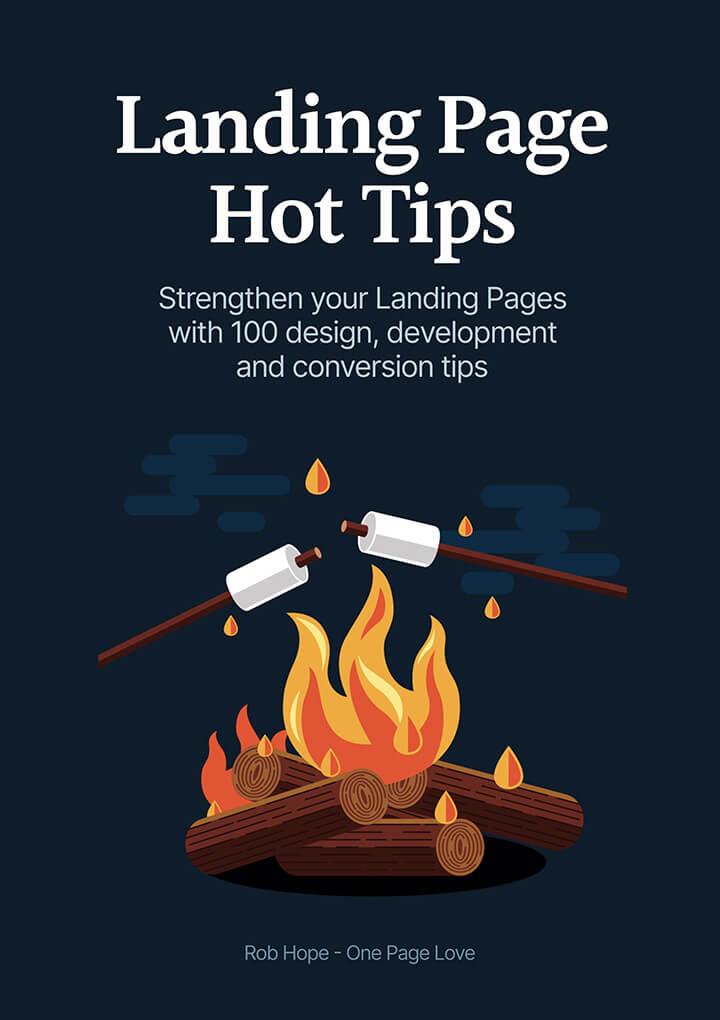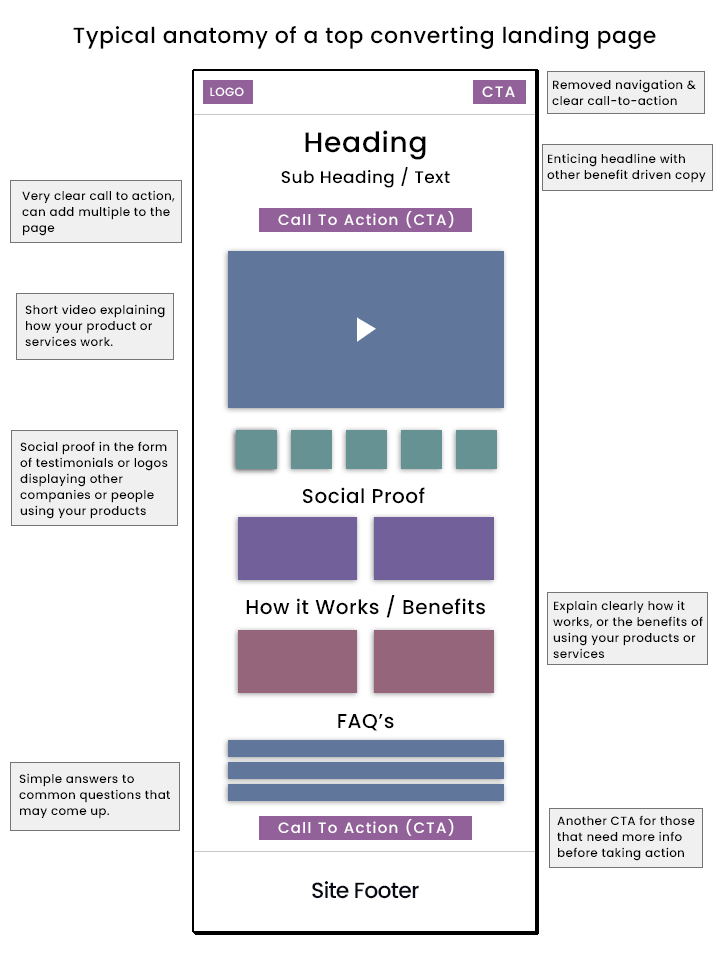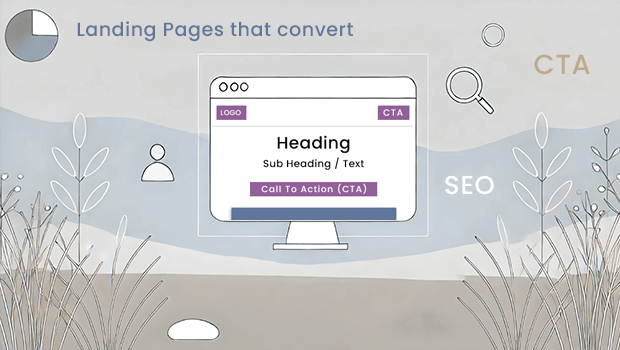So, you have your website set up, you’re selling products or services, but you find that your website traffic is not converting into sales as much as you’d like it to… Well, then let’s look into building dedicated landing pages for your different products or services.
In this ultimate “Guide to Landing Pages That Convert”, my goal is to quip you with the skills you need to build successful landing pages that convert.
Let’s first get an understanding of…
What is a landing page?
Unlike a typical website page, a specially designed landing page is a dedicated web page which is focused on capturing your visitor’s attention and encouraging a specific action or driving a conversion.
The power of a landing page is it’s simplicity and focus. By removing distractions such as site navigation and multiple calls to action, landing pages are usually more successful in converting visitors into leads or customers.
When a user clicks through to your landing page from an online ad, email link, or social media post, they are directed straight to your landing page which is tailored to match the intent of their click. The purpose of a landing page can vary… It might be to gather email subscriptions, prompt a download, showcase a product, or aim to drive a sale.
However, the core idea remains the same: guide your visitor towards your landing page and get them to complete a predetermined action.
The 4 Main types of landing pages
There are 4 main types of landing pages that you can build, depending on the goals you are trying to achieve. Understanding these 4 types of landing pages will help you to choose the right landing page to build for your products or services.
Below are the four main types of landing pages I think you should know:
Lead generation landing page
A lead generation landing page, which is also known as a lead capture page, is designed to collect your site visitors information, such as their name and email address. This type of landing page is often used when you’re building a database of emails to regularly email about products or services, whether you start Affiliate Marketing or you have your own products or services, I recommend always collecting email addresses as it’s a great way to recommend products or generate more site traffic back to what it is you’re offering.
In Lead generation pages, you generally offer something valuable (a Lead Magnet) in exchange for your site visitor’s information, such as an eBook, a webinar, a free trial, or a discount code… Give them some incentive to sign up to your email marketing list.
Click-through landing page
A click-through landing page acts as a middle step between your online ad, email link or product purchase page. The main purpose of this type of landing page is to warm up your potential customers, and gain more of their trust before they are directed to the final purchasing page.
Click-through pages usually don’t have signup forms like the lead generation page, they will rather have a video introducing yourself or your business, give the user more product details or benefits, or display other users testimonials to gain more trust.
Squeeze landing page
A squeeze landing page is a specific type of lead generation page with a single focus: to capture your visitor’s email address. This is the type of landing page that you will setup if you’ve built a sales funnel and are focusing on selling your products.
These pages are usually very minimalistic, offering just enough content to persuade the visitor to share their email in exchange for a small but valuable offer, and you might even build a click-through or ‘bridge’ page after this to gain the users trust before displaying your products or services.
Sales Landing Page
A sales landing page is designed with one goal in mind: driving sales. This type of page is often longer and more detailed than other types of landing pages because it needs to provide enough information to convince your visitor to make the purchase.
Sales landing pages usually include persuasive copy, detailed product descriptions, images, social proof such as testimonials, and a strong call-to-action (CTA).
Thank You Landing Page
A thank you landing page, as you’ve probably guessed, is displayed after your visitor has completed the desired action, such as signing up to your email newsletter or making a purchase.
While it may seem like the end of the journey, this type of landing page is perfect for confirming the completion of your visitor’s action, providing additional information or next steps, and… A thank you landing page is also a great way to offer further engagement opportunities or other recommended products.
Tips to create high converting landing pages
Creating a landing page that effectively converts your visitors into leads or customers will need some planning and optimization. In this ‘Guide to Landing Pages That Convert’, I’ll list some of the top proven tips to help you design landing pages that will drive results:
1) Target long-tail keywords
Long-tail keywords, or keyword phrases, are typically longer phrases with the targeted keywords in them, which make them less competitive than broad keywords.
Example 1: An Ecommerce Store Selling Running Shoes
- Broad Keyword: “running shoes”
- Long-Tail Keyword: “best running shoes for marathon training”
Targeting keyword phrases like that can help you attract a more qualified audience – visitors who are further along in their buying journey and more likely to convert. Incorporate these keywords naturally into your landing page’s headline, subheadings, and body content to improve your search engine ranking and draw in visitors who are looking more specifically for what you are offering.
2) Work on page loading speed
One thing about a website or a landing page… Visitors DO NOT like to wait! Visitors are likely to abandon a page if it takes more than a few seconds to load.
A slow-loading page can significantly hurt your conversion rates. To ensure your landing page loads quickly, optimize your images, use fast web hosting, and minimize the loading of lots of scripts. Tools like Pingdom can help you identify areas where you can improve your page speed, ensuring a smoother and faster user experience.
3) Remove distractions and clutter
The success of a landing page can also be affected by its ability to focus the visitor’s attention on a single goal – and getting them to complete the desired call-to-action (CTA).
So it’s advised to remove any unnecessary elements like navigation menus, sidebars, or multiple links that can distract visitors and lead them away from the primary action you want them to take.
A clean, uncluttered design will help keep visitors focused and improve your chances of converting them.
4) Write an enticing headline
Your headline is usually the first thing your visitor will see, so try to make sure it grabs their attention and clearly communicates the value of your offer.
An enticing headline, as well as the other copy on your landing page, should be clear and concise, benefit-driven, and make it clear for your visitor to know why they need your product or service.
5) Position your CTA’s above the fold
The placement of your call-to-action (purchase button or form, etc) is pretty crucial for maximizing conversions.
Make sure that your primary CTA is positioned above the fold – meaning that it is visible without the user needing to scroll down the page. This makes it immediately accessible to your visitors, increasing the likelihood that they will engage with it.
You can also include secondary CTAs further down the page to capture those who prefer more information or social proof before taking any action.
6) Provide social proof
Social proof, usually in the form of customer testimonials, reviews, case studies, or trust badges, can significantly boost the credibility of your landing page and will persuade your site visitors to take action.
When potential customers see that others have had positive experiences with your product or service, they are more likely to trust your offer and convert. Only include authentic, relevant social proof that will resonate with your audience and reinforce the value of your offer.
By implementing these tips, you can create landing pages that are not only visually appealing but are also highly effective at converting visitors into leads or customers. However, there’s is more to optimizing your landing pages than just following these tips above.
Guide to Landing Pages That Convert: Landing Page Hot Tips:
If you’re really looking at taking your landing pages to the next level and want to build top converting landing pages! Then I highly recommend you purchase this “100 Landing Page Hot Tips” Ebook which will explain everything you need to know.
When You Purchase the Ebook, You’ll Receive:
- The Ebook: You’ll get access to both the digital and PDF versions of the Ebook, allowing you to read it on any device at your convenience.
- Audiobook: Enjoy a concise, no-fluff 54-minute audiobook featuring all the hot tips, perfect for on-the-go learning.
- Interactive Checklists: Get a set of interactive checklists to use before launching your landing page, including a Pre-Launch Checklist, Testimonial Checklist, Pricing Checklist, and more, ensuring you don’t miss any critical steps.
- Category/Component Filters: With 100 actionable tips, you can easily filter and sort them by category or component based on your specific needs. Browse by category (Conversion Tips, Marketing Tips, Pricing Tips, and more) or by component (Buttons, Headlines, Demos, and more) to find the exact advice you need when you need it.

The importance and benefits of a landing page
Landing pages are essential for driving conversions by focusing on a single call-to-action, offering targeted messaging, and improving the ROI of your marketing efforts. With fewer distractions, dedicated landing pages will guide your visitors toward specific actions, leading to higher conversion rates.
Additionally, landing pages allow for valuable data collection, enabling better audience insights and continuous optimization through A/B testing, ensuring maximum effectiveness in achieving your marketing goals.
Some FAQ’s on creating landing pages:
I’ve done some research and I’ve come across some frequently asked questions that have been asked when creating high-converting landing pages, and I thought I’d give the answers to them in this ‘Guide to Landing Pages that Convert’.
Can any page be a landing page?
Technically, any page can be a landing page, but it may not be as effective.
A dedicated landing page is specifically designed with a single, focused objective, such as capturing leads or driving sales, and is free from distractions like the site navigation or any other links.
I have a website product page, do I still need a dedicated landing page?
Yes, a dedicated landing page is still valuable even if you have a product page on your website. Product pages often serve multiple functions and include various navigation options, which can distract visitors.
A landing page, on the other hand, is tailored to a specific campaign or audience, with a clear call-to-action designed to maximize conversions for that particular offer.
How can I easily create a landing page?
Creating a landing page is easier than ever with the variety of tools available. Many landing page builders, like Systeme.io, ClickFunnels, or even Elementor, offer drag-and-drop interfaces that require no coding knowledge.
These platforms also provide pre-designed templates, making it easy to create professional-looking landing pages quickly.
Can I have a landing page without a website?
Yes, you can definitely have a landing page without a full website. This will more likely be a Sales Funnel then.
Many landing page builders allow you to create standalone pages that can be hosted on their platforms or on a custom domain. This is a great option for specific campaigns, product launches, or lead generation efforts where you don’t need a full website.
How long should a landing page be?
The length of a landing page should be determined by what you are offering, and the amount of information your visitors need to make their decision.
For simple offers, like a free download, a short page might be more effective.
For more complex offers, such as high-ticket products or services, a longer page with detailed information, testimonials, and case studies may be necessary to convince visitors to convert.
The key is to include only the content necessary to persuade the visitor to take action.
What is the best landing page builder?
The best landing page builder really just depends on your specific needs and budget. There are a lot of systems out there that are very good for building websites.
Elementor is an excellent choice for WordPress users, offering robust design tools and seamless integration with existing sites, or Systeme.io for if you’re looking to build just a sales funnel.
Each of these tools offers unique features, so the best choice will depend on your goals and technical comfort level.
Common Landing Page mistakes to avoid
Even well-designed landing pages can fall short if certain mistakes are made.
One common error is having too many distractions, such as navigation menus or multiple calls-to-action, which can confuse visitors and reduce conversions. Another mistake is using generic or weak headlines that fail to capture attention and communicate the value of the offer. Slow page loading times can also be a major deterrent, causing visitors to leave before the page fully loads… And failing to include trust signals, like testimonials or security badges, can undermine credibility and discourage visitors from taking action.
Avoiding these mistakes can help ensure your landing pages are more effective and successful in achieving your goals, so again, I recommend looking into purchasing the 100 Hot Tips Ebook to ensure you are creating the best landing pages for your products or services.
The anatomy of top converting landing pages
Below is an image displaying some of the typical high-converting landing page tips, and while these are only some of them, it’ll give you a basic understanding of what to build and be some sort of guide to landing pages that convert.

How to Measure the Success of Your Landing Page
Measuring the success of your landing page is pretty essential to understanding how well it’s doing, and to identify areas where your landing page can be improved. Some of the key metrics to track include your conversion rate, which is the percentage of visitors who complete your desired action, such as signing up to your newsletter or making a purchase.
A high conversion rate means that your landing page is working well with your audience and it’s successfully driving them to take action.
Another important metric to measure is the bounce rate, which shows the percentage of visitors who leave the page without any interaction. A high bounce rate could signal that your landing page isn’t engaging or relevant enough. Time on page is also a valuable metric, as it indicates how long visitors are staying on your landing page, suggesting their level of interest and engagement.
Additionally, it’s advised to track your traffic sources, to get a better understanding of where your visitors are coming from, whether it’s social media, email campaigns, or paid ads. Tracking your traffic sources can help you to refine your marketing strategies and focus on the channels that drive the most valuable traffic.
By regularly analyzing the important metrics on your site, you can continuously optimize your landing pages for better performance and higher conversions.
A/B testing your Landing pages
A/B testing can be a very powerful technique for optimizing your landing pages, it involves comparing two or more variations of the landing page to see which one performs better.
By testing different elements – such as headlines, images, CTA buttons, and layout – you can identify what resonates most with your audience.
For example, you can create two versions of a landing page with different headlines and track which one leads to more conversions.
The key to successful A/B testing is to change only one element at a time, allowing you to pinpoint exactly which improvements are working best. Over time, these incremental changes can lead to significant gains in conversion rates, helping you refine your landing pages more and more.
Guide to Landing Pages that Convert: Conclusion:
I hope I’ve provided enough information for you to have a clear understanding on what you need to do.
By understanding what you need to do, along with the 100 Landing Page Hot Tips Ebook, and going through the checklist you’ll receive, you should be able to build a solid landing page that consistently deliver results.
So, whether your goal is to generate leads, drive sales, or promote a special offer, creating a well-crafted landing page is essential in your digital marketing venture.
Remember, also, the key to success lies in simplicity, relevance, and providing a seamless user experience that guides visitors toward a single, compelling call-to-action.
Get the best 100 Hot Tips on creating your landing pages now!


Leave a Reply